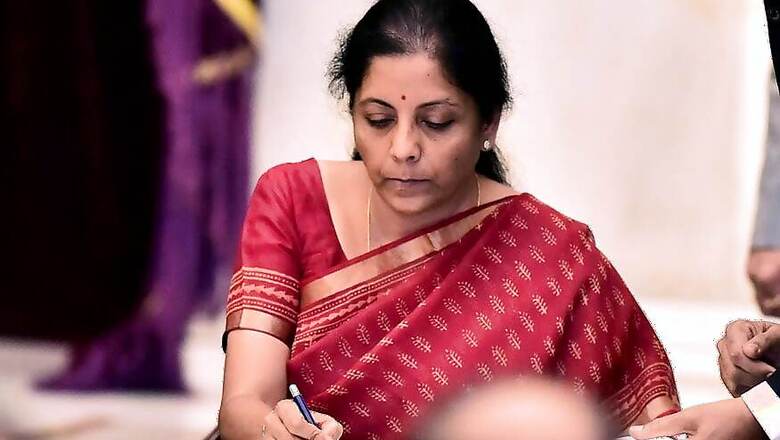
views
The portfolios of ministers in Modi 2.0 regime have been announced and Nirmala Sitharaman is the new Finance Minister. Of all the ministers, Sitharaman arguably has the toughest task since she will inherit the two biggest headaches of the last government: a slowing economy and the task of large scale job creation.
In fact, some would say Modi government’s second term could well be more challenging than the first, largely due to continuing economic woes and that Sitharaman will have to find ways and means to accelerate growth.
The economic data released by the CSO on the government’s first day in office underlined the gravity of the situation and the enormity of the task Sitharaman faces. GDP growth fell to a nearly five year low in the January-March period (Q4) of fiscal 2019 and below the 7% mark for the full year, according to government data. Also, separate data released by the Labour Ministry showed unemployment rate of 6.1% for 2017-18. Though the government said this number was not comparable with previous survey results, this was a record high rate of unemployment.
Analysts at brokerage Elara Securities have described the current troubles of the economy thus: “if there was ever a time since May 2014 that India needed Modi to pull a rabbit out of the hat and turn around economic prospects of the country, it is today. Reeling under consumption slowdown amid liquidity crisis in the NBFC sector and lower terms of trade in the agriculture sector, optimism around India’s economic growth has come to a grinding halt. With limited fiscal space amid compelling priorities and electoral promises, Modi government’s second term in office is likely to be more challenging than the first.”
That India’s economy has been slowing down is no longer a matter of debate. At the fag end of its first term, the Modi government itself had quietly acknowledged this slowdown. The last monthly report released by the Finance Ministry for April had said "India’s economy appears to have slowed down slightly in 2018-19" and had gone on to blame declining private consumption, muted exports and tepid increase in fixed investment for this slowdown.
Fitch group company India Ratings had pointed out last week it expected March quarter GDP growth to decelerate to 6.3% (from 6.6% in the December quarter). Growth obviously came in even lower than expectations.
India Ratings also said 2018-19 was the second consecutive year of an economic slowdown in India and arresting this slowdown, reviving the economy will be the first challenge for the new government.
“The new government will have to devise and execute both short-term and medium-to-long-term measures to arrest the slowdown. While cyclical challenges can be addressed through short-term measures, the need of the hour is to address the structural challenges plaguing the Indian economy.
At the macro level, the revival of investment (1QFY18: 3.9%; 1QFY17: 15.0%), the resolution of the credit freeze witnessed by the non-banking financial sector and the worsening of the global trade environment (export growth: 1QFY18: 4.9%; 1QFY17: 3.6%) are the key challenges,” India Ratings has said.
Let us look at revival of investment: though it is an obvious tool, increasing public investment would be a very tough call for the new Finance Minister since our fiscal position is already stretched. Also, analysts refer to historical data on government expenditure growth and point out that central government expenditure growth slows in the year following a general election.
Apart from public investments boost, another tool in the hands of the government would be pushing the RBI to cut interest rates so that cost of funds for banks comes down and loans become cheaper for consumers. Already, the RBI has cut rates in February and April this year and may oblige yet again next month. But will these measures be enough to catalyse the economy?
A huge question mark already hangs over the jobs scenario. The Elara analysts said that quoted the Centre for Monitoring Indian Economy (CMIE) estimates to say that unemployment was at a “29-month high of 7.35% in April 2019”.
Post demonetization and GST, the unorganized sector has been reeling under pain that probably is the main factor leading to weaker job creation.
Also, GST compliance in the organized sector has forced digitization of business transactions and has led to a preference for organized-sector suppliers. The informal sector has struggled to deal with the new complexities and priorities, and so has ended up losing business from the organized sector. Given all these constraints, job creation would also be a tough road for the new FM.
Will a fiscal stimulus package, the likes of which we saw in 2009, emerge from the new government? Analysts Sanjeev Prasad, Sunita Baldawa and Anindya Bhowmick of Kotak Institutional Equities have suggested a “directed fiscal stimulus (housing, for example)” to derive maximum gains from any limited fiscal stimulus as there is limited scope for broad fiscal stimulus.
India suffers from (a) high and persistent fiscal deficit (b) faltering tax revenues (c) broken business models in agriculture and infrastructure. The three analysts have also spoken about a broad monetary stimulus in the form of rate cuts from the RBI and widespread but difficult economic reforms.
(Author is a senior journalist. Views are personal)



















Comments
0 comment